TOPOGRAPHY DISARRANGED: Landscape, Dislocation & Place
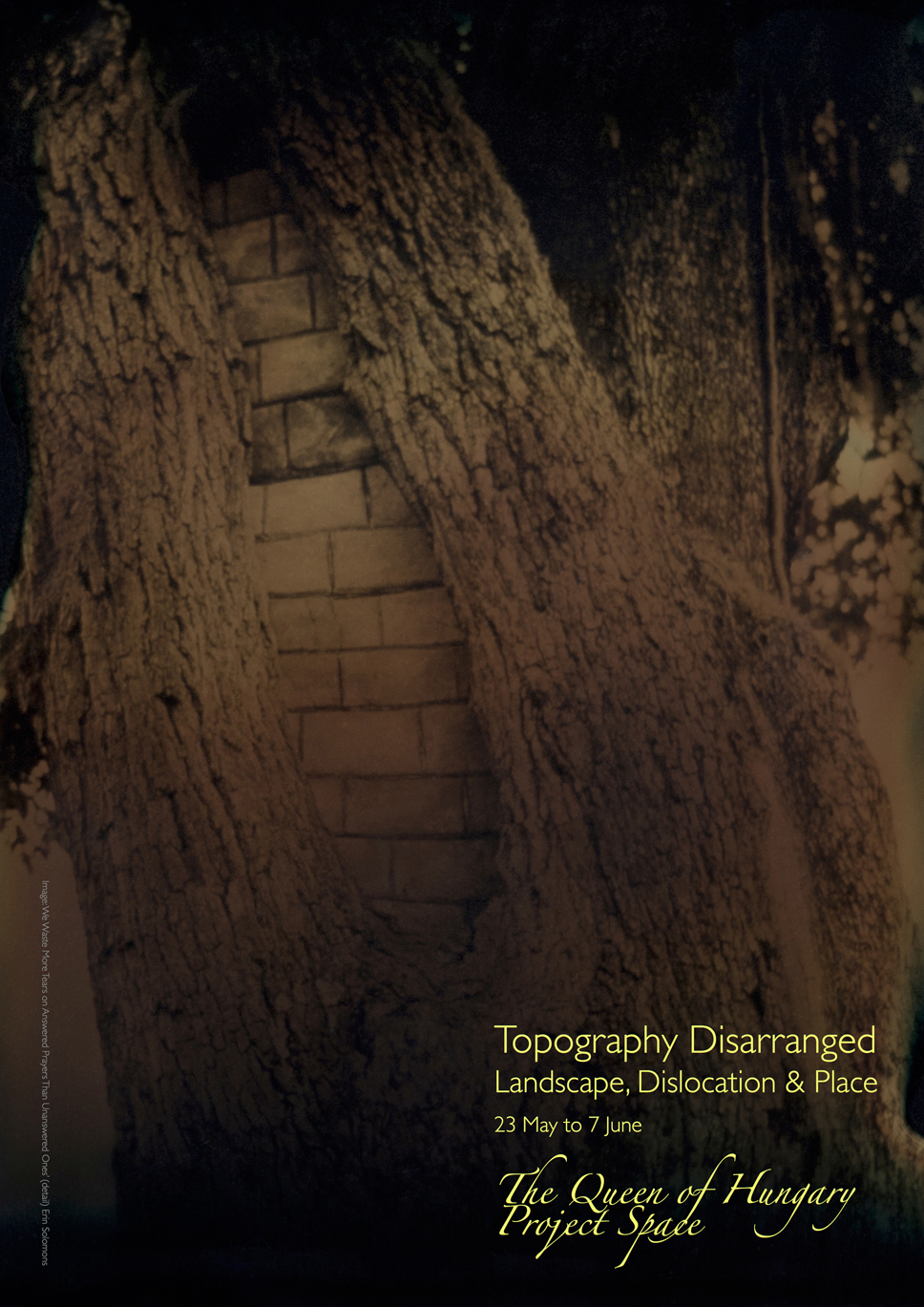
Artists' Moving Image Night 23rd May 7pm:
KATERINA ATHANASOPOULOU
MARIANNE HOLM HANSEN
MICHAELA NETTELL
DAVID ROGERS
EDWIN ROSTRON
TIM SIMMONS
JOE STEVENS
Project Space Blog
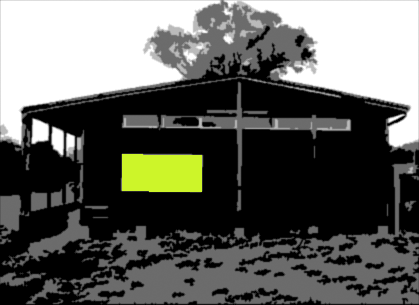
TOPOGRAPHY DISARRANGED: Landscape, Dislocation & Place |
|||||||
|
23RD MAY - 7TH | JUNE 2014 | Events | ||||
| Projects | |||||||
|
Classes | ||||||
Artists' Moving Image Night 23rd May 7pm: |
|||||||
KATERINA ATHANASOPOULOUMARIANNE HOLM HANSENMICHAELA NETTELLDAVID ROGERSEDWIN ROSTRONTIM SIMMONSJOE STEVENS |
About | ||||||
| Contact | |||||||
Project Space Blog |
 |
||||||
Exhibiting Artists: |
Selected by Paul Fieldsend-Danks, Eliza Gluckman and The Queen of Hungary Project Space |
|
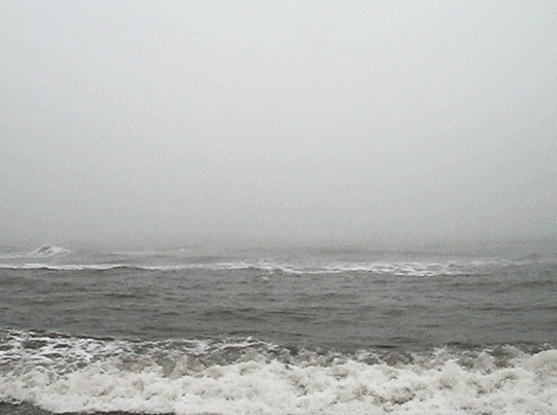 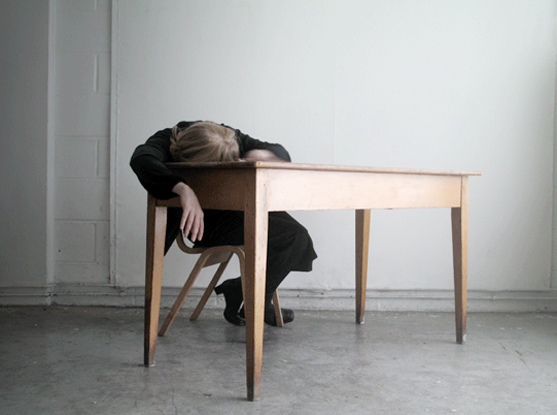 |
MARIANNE HOLM HANSEN Marianne Holm Hansen: further information 'Residue/Small Wide Views', Marianne Holm Hansen, 2008 on |
'Residue/ Small Wide Views' combines two long-term projects – Residue of Praxis (ongoing, since 2008) and Small Wide Views (ongoing, since 2006) – to explore the relationship between site and the potential dislocation, or residue, of site-specific experience. Both projects deliberately use the format of stop-frame animation to consider divergent notions of memory in relation to the making and re-making of place, through repetition, movement and photographic representation. By displacing views from one location onto another through projection, Small Wide Views attempts to make the experience of fixed locations transportable, to re-present place or to re-create place as a space for reflection. The views represented are of sites that have previously been the place of national protest, international conflict or domestic arguments. Although this is pivotal to the choice of locations when creating the works, their presentation – as the sites themselves – carries no indication to the fact that these seemingly quiet landscapes were once the place of war, disagreement or dispute. Instead, as the sites themselves, they leave the viewer to use their own memory and experience to create any meaning from their encounter with them. The same is true for the works created as part of the in the ongoing project Residue of Praxis. However, while Small Wide Views may abstractly question what constitutes a suitable site for memory and memorial, remembering and remembrance, Residue of Praxis documents the acting-out of responses to place and its history. Residue of Praxis is simultaneously an exercise in trying to determine how site-specific memory manifest through the body and its movements and an attempt to exorcise, through repeated physical reenactment, any embodied memory that otherwise may be continually carried from one place to another, continually affecting the body - including gesture, behavior, experience and understanding. By presenting the works side by side, 'Residue/ Small Wide Views' hopes to create a situation where it may be possible to think through the relationship between place and experience; in particular, to more fully explore the potential embodiment, and subsequent dislocation, of the effects and affects that may results from occupying a particular landscape, site or situation. |
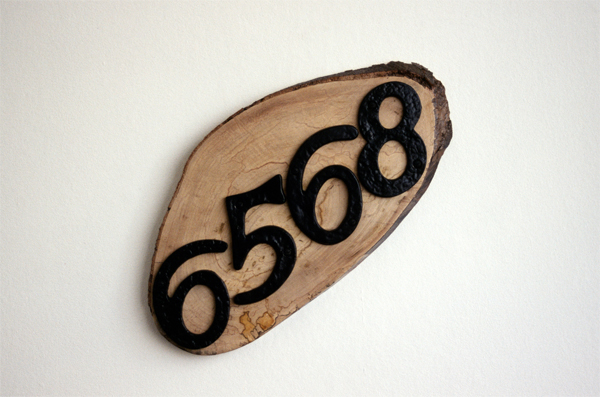 |
LAURA NAPIER Laura Napier: further information 'Your Place', Laura Napier, 2011 |
'All The Places I Have Been, All The Things I Have Seen' subverts the iconic British gentleman’s bowler hat through its customisation with souvenir pin badges from around the world. The work is a portrait of a well-travelled man who records his journeys across continents and landscapes through collecting. Each pin reduces an entire place, city, Country, landmark, to a visual prompt for the memory of its owner. The piece was started in 2010, and is continually added to as the collection grows, until there is no space left on the hat. Eventually the piece will be part of a larger series of hat portraits exploring a very particular ritualistic form of display and, the imaginary character’s physical lifelong record of their movement through, and connection to varied landscapes. When worn, the hat communicates the character’s visitor status, symbolising their displacement from, all these places they have been, and all the things they have seen, as well as a nomadic estrangement from where they originated. 'Your Place' is wall-based piece consisting of found door hardware mounted on a slice of log. It adopts a suburban English vernacular and has a D.I.Y aesthetic. However the long number implies an extensive road, a property at 6568. The length of the road is non-European, and could only relate to the infrastructure and, landscapes of places such as America, Australia and South Africa. The imagined location floats adrift between these landscapes and cultures, much like the fictional inhabitant, both are displaced. The title of the work can be interpreted in two ways, the property which somebody inhabits and its location, or somebody’s social standing. The title alludes to a visit, the colloquial sentence ‘come round my place’. The number is personally significant to the artist and is the institutional number, of someone both physically and socially displaced. |
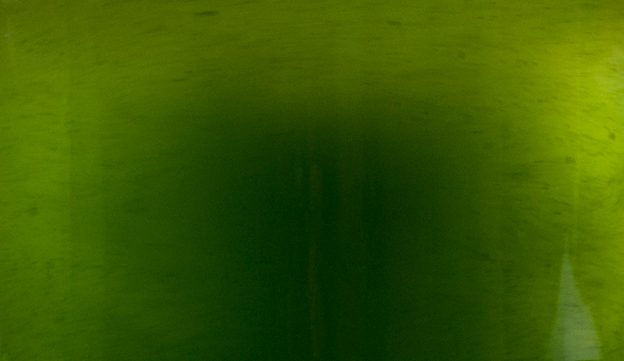 |
JAIMINI PATEL Jaimini Patel: further information 'One Green Bottle', Jaimini Patel, 2014 |
The colour that can be seen in 'One Green Bottle' belongs to Chlorella vulgaris: a single-cell alga that is photosynthetic, sharing properties with both organisms and plants. These micro-algae that are smaller than human red blood cells become visible in numbers. Brought into the gallery space the cells perform within a restricted environment to which they readily adapt. The colours created are indicators of existing conditions. The temperature of the room and availability of nutrients, air and light determine the appearance of the water. The brightness, intensity, shade and hue are not arbitrary, but carry a wealth of information. Colour that might at first appear to be stable is revealed to be in flux. The fluorescence of the green, the distribution of colour and its propensity to change, signal that the colour is multiplying. Despite its ability to thrive, as the title suggests, this living green is vulnerable. |
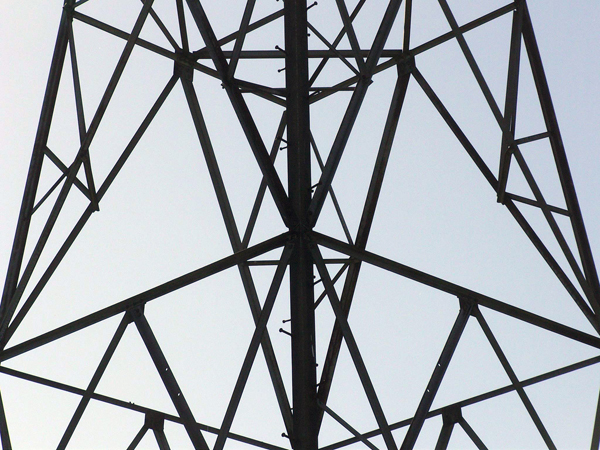 |
OLIVER PAYNE Oliver Payne: further information 'Recording pylon songs, Happisburgh', Oliver Payne, 2013 |
‘Cycle’ is a 30 minute looping sound collage that captures the abstract and literal essence of the local landscape – the piece consists of pure and processed recordings of various environments from around the Queen of Hungary site, recorded from April 2013 to April 2014. Much of my work focuses on the localisation and decontextualisation of sounds to make them unrecognisable to their original form or setting. Dislocation is portrayed as typical sounds in unfamiliar contexts and the destruction of sounds we commonly perceive as beautiful. Dislocation is to be disrupted or removed; ‘Cycle’ conveys this as discomfort as well as remaining attractive and unchanged, much like our beautiful landscape. A range of recording equipment and techniques were used to produce a rich and dynamic texture; hydrophones to collect the sounds from rivers, lakes and sea; piezos to collect audible silence and vibrations; electro coils to record the hum of overhead power lines and numerous conventional microphones. ‘Cycle’ is at times beautiful and at others quite the opposite. ‘Cycle’ is mixed as an infinite loop, there is no beginning and there is no end. |
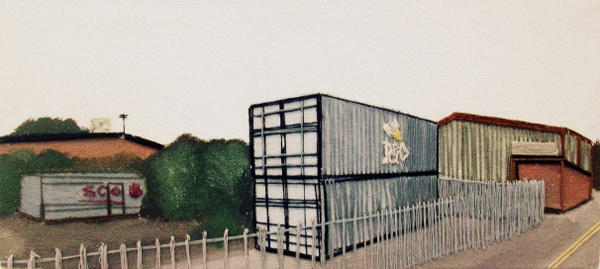 |
AMY PREBBLE Amy Prebble: further information 'Syston Street', Amy Prebble, 2012 |
Amy's work draws on concerns about the ever-changing and evolving contemporary urban landscape. Amy highlights this by taking bleak, perhaps uninteresting imagery and turning it into engaging pieces. The elements chosen are fixtures that may be designed by town planners to receive only passing attention; here they are subjected to sustained scrutiny. The fixtures are flattened and simplified, separated from their surroundings and given a tactile presence that encourages a physical connection. Embroidery is utilised as an attempt to document these continually evolving urban landscapes. The threads allow certain information and details to be selected, brought forward and placed in prominence. For Amy, stitch connotes mending; holding a torn and fragmented world together. Amy’s pieces attempt to embody psychological qualities, allowing the viewer to re-engage in and relate to an urban landscape, by reminiscing about similar, familiar spaces. The miniature scale of the image encourages viewers to peer, probe and perhaps engage more deeply. Amy has created a succinct series of typologies that show similarities within compared areas. This encourages the viewer to see both separate views as well as comparative passages in a single, overarching landscape. |
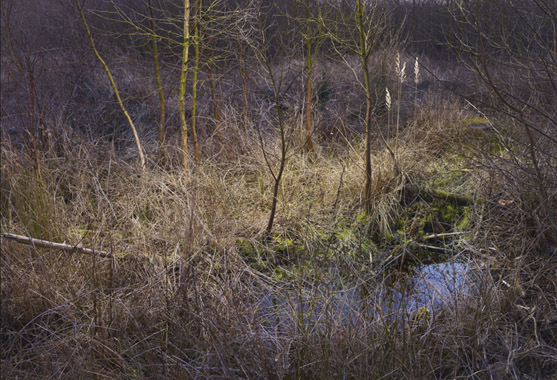 |
TIM SIMMONS Tim Simmons: further information 'Swanton Novers #9', Tim Simmons, 2012 |
This photograph is from an ongoing body of work started in 2002. Tim's practice has evolved through his own personal experience of landscape, and an exploration of its impact and relevance in our lives. By isolating scenes in everyday landscapes, he creates windows into places that are easily overlooked. The artist's intention is to confront the viewer with the intricate details contained in these large, almost life-sized photographs, inviting us to explore them as though in attendance. Spending time studying these works intimately, and acquainting ourselves with the space, we are able to transform it into a place. Becoming familiar with a landscape can lead towards an increased sense of belonging, where open spaces become places of meaning and relevance. We interpret our surroundings through experience, and create values based on our ideologies and memories. A sense of belonging is a basic human need, and finding identity through place is an important part of who we are. Scientific research shows the benefits of physical engagement with our surroundings, which helps to promote our sense of identity and belonging. Tim's work examines the disconnection we have with our surroundings, and the impact of this isolation, exploring the themes that link our lives with the natural world and prompting us to reengage with it. Working with photography and film, Tim's practice considers the constancy of the land, while simultaneously exploring the concept that landscape is the link between what we were and what we have become. |
 |
ERIN SOLOMONS Erin Solomons: further information 'We Waste More Tears On Answered Prayers Than Unanswered Ones' (detail), Erin Solomons, 2013 |
Erin's work questions a common theme in landscape photography, that is, to capture the beauty of a space, instead of the relationship with it or the connected experience. In addition to asking little investment from the viewer, this can limit the genre’s potential. Raw materials that allow tactile associations can accentuate the undertones of a work and enable felt connections towards it. When the audience is presented with images and visceral materials, options of interaction are opened up with both representations in the photography and the tactile experience of the objects. This work originates from Erin’s recent project based on the Southern Gothic landscapes of southeastern Georgia, U.S.A. Oak trees and Spanish moss are a commodity in this particular region. However, when oak trees become diseased, a typical practice is to cut, hollow out, or fill them, instead of removal. This treatment of trees can be seen as a metaphor for the continual compromise a person makes in their identity between the needs of the inner ‘self’ and being accepted within society. During the Civil War era, tintypes were keepsakes used to remember loved ones. By combining the tintype process with the tree portraits, Erin constructs a geographical and historical reference to the images, acting as a compass to the relationship. The physical experience of these palm-sized, thin metal sheets can emphasise the preciousness of an identity, but also its fragility. |
KEEF WINTER Keef Winter: further information 'Let's Build our own tomb', Keef Winter, 2014 |
'Unassuming, all consuming' consists of four sculptures that act as an abstracted maquette of a city block. Each piece will be partly cast in concrete using debris sourced from a particularly potent space in London. These potent spaces are micro points of interest found by drifting through the city and investigating locations where a stored energy exists. The spaces chosen seem relatively unremarkable in their urban status but relay a much further potential; a concrete column, a curious corner of disrepair, a dissonant party spot, a sterile site of commerce. Deliberately sourcing this aggregate from these parts of London, the pieces aim to condense a fragmented urban landscape of the city into a set of forms that hint at their origin. |
|
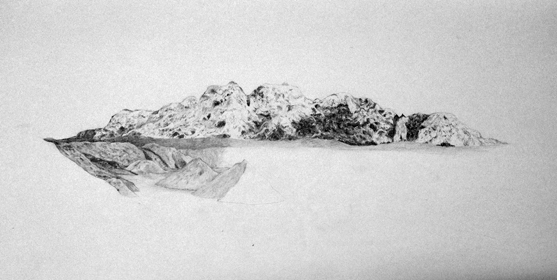 |
DECLAN WOODS Declan Woods: further information 'Untitled', Declan Woods, 2014 |
Declan Woods' practice utilises the process of drawing as a tool for mediation between the representation of place and the metaphysical act of visualising the world we inhabit. Drawing allows the artist an immediacy and intimacy that commemorates the act of thinking in mark and gesture. In this work, the editing process inherent in drawing is mirrored in the subject, where the extraction of raw material forms a synthetic landscape. |
KATERINA ATHANASOPOULOU Katerina Athanasopoulou: further information 'Apodemy', Katerina Athanasopoulou, 2012 |
'Apodemy' is a film about emigration and the economic crisis, based on Plato’s metaphor of the mind as a birdcage: we’re born with the cage empty and fill it with knowledge/birds to be recalled/grabbed at a later time. The film follows a caged trolleybus moved by migratory birds, seeking escape from a half-finished and abandoned city. Economic emigration is an act of dislocation, where the journey taken is felt as a breakaway from the landscape of origin, disrupting personal and social life. The features of the city are skeletal, cracked and disintegrating. In Plato’s birdcage, we actively put our hand in the birdcage/mind to grab a thought. In Apodemy, these hands are the broken statues of past leaders that have been moved from hero to villain and are also in a state of dislocation: moved by cranes they disrupt the migratory journey of the trolleybus and send it to its fall. In times of social change, there’s always a ceremonial, enthusiastic smashing of public art depicting leaders that have been dethroned. Following their fall, they get transported in a shameful journey as scrap, however the ideas that they represent may still come back to haunt us. As a migrant, Katerina looks back at the landscape of Athens she left behind before the crisis; the one she faces now fills her with a profound sense of alienation, with buildings, people and values visibly collapsing. In the film there’s a sense of abandonment, of changing location as an enforced journey away that can only lead to further disruption. As the trolleybus falls, there is no real end to the journey. The birds may find it again and re-start the process of migration, turning the act of dislocation into a circular pattern that is forever broken and forever going on. |
|
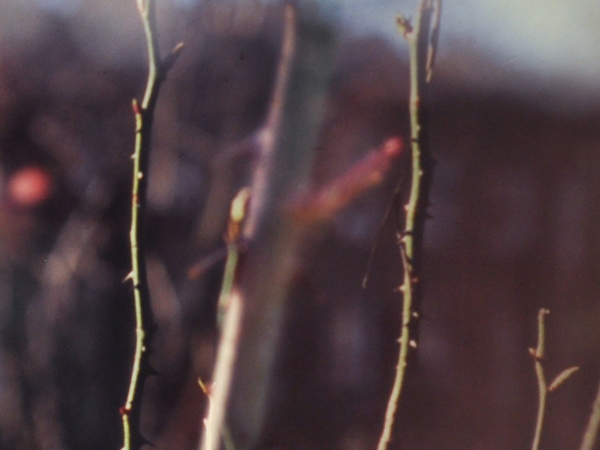 |
MICHAELA NETTELL Michaela Nettell: further information 'Garden (still)', Michaela Nettell, 2012
|
'Garden' is an experimental video produced during a twelve-month residency at Culpeper Community Garden in London. Pairs of 35mm slides are projected, overlaid and re-photographed to create double exposure effects. These photos are then sequenced to create illusions of movement. The work describes a private experience of the public space of an urban garden, considering the balance between sociality and solitude in a site that is both collectively shared and a haven to pause and reflect. The process of layering and re-capturing the projections, zooming in and scrutinising small details within the frame, defamiliarises the environment to reveal strange and ambiguous image-worlds and establish a new, personal sense of place. The audio is fabricated from SoundField recordings captured in the garden and neighbouring locations. Guided by duration, flicker and time passing in the image, the interleaved sounds reflect the process of double exposure and compose distances between the photographer's lens and the bustling city around. |
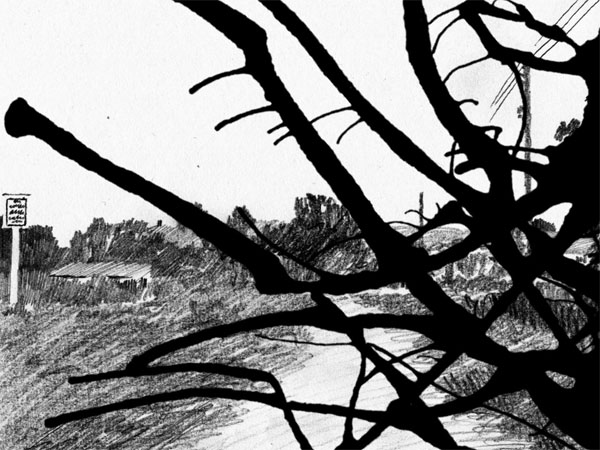 |
EDWIN ROSTRON Edwin Rostron: further information 'Our Selves Unknown', |
‘Our Selves Unknown’ takes a book entitled ‘Landscape in Distress’ as its raw material, reconfiguring its photographic illustrations, text and cover design into a series of animated drawings. Phrases and images from the book are isolated and transformed into something new, cryptic and unsettling. Published by the Architectural Press in 1965, ‘Landscape in Distress’ was written by Lionel Brett, a British peer, architect and town-planner. The book examined 250 square miles of Oxfordshire, recording "in intimate detail the post-war changes and present state of the landscape of a typical section of […] Britain." It described the damage that had been done to the area and tried to alert the reader to “the inevitable damage that lies ahead”, drawing specific attention to the increasing homogenisation of areas on the edges of cities. The book’s sense of horror at the violence of this process is retained in the film, though stripped of its original context and meaning. Ambiguous tangled forms derived from Philip Thompson’s cover design dance over the screen, an unruly and malevolent presence which might be consuming the landscape, or might just be on the surface of our own eyes. |
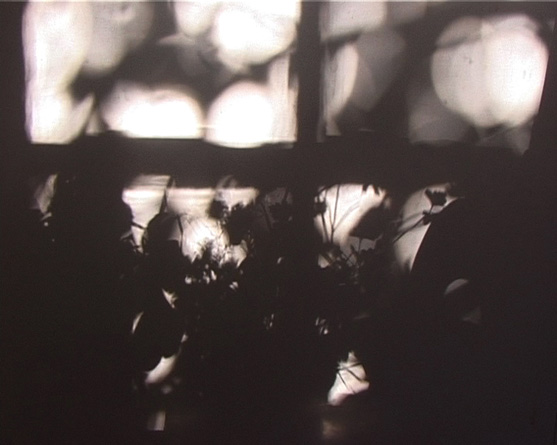 |
DAVID ROGERS David Rogers: further information 'Shadow Drawing 1', David Rogers, 2012 |
'Shadow Drawing 1′ is a video field recording of ‘pure’ shadows, with no intervention on either surface, form or colour and with no digital manipulation other than editing. |
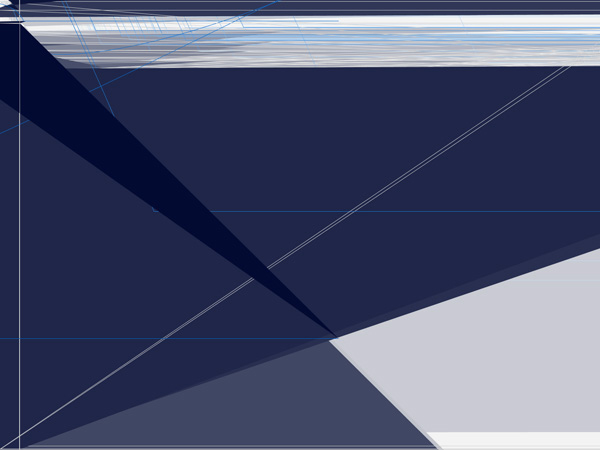 |
JOE STEVENS Joe Stevens: further information 'Reinventing the landscape', Joe Stevens, 2012 |
Joe's drawings begin by taking a walk with a GPS recorder, recording the locations (how far, how fast and how high travelled for example). This data is transferred into a program where the GPS data is interpreted by a set of personal parameters. The data is read in a sequence that follows the walk and this is translated as images that develop frame by frame to create a moving image. The resulting film captures the ephemeral act of wandering itself – in fleeting scenes unfolding and then disappearing before they have begun to fully form. The work extends drawing to include the technology of scientific instruments, such as GPS recorders, in order to challenge the assumptions of what drawing is or might be. The artist’s key field of activity is the public space. Photographs, sound, video and writing, which all testify to how we use public space, how we move through it, sit in it, lounge or conduct ourselves in it, and above all how we relate our personal realm or inner landscape to other people and objects. Though these pieces utilise new technology, they are strongly informed by the aesthetics of English geometrical abstract art and informed by a number of 20th century art movements that focused on fundamental geometric forms. These movements replaced identifiable brush marks with anonymous monotone surfaces, free lines with ruled lines and complexity with apparent geometric simplicity. Artists such as Barbara Hepworth and Ben Nicholson drew inspiration from the science, technology and mathematics of their day, using these as new visual stimuli to develop fresh ways of thinking and working within a lyrical landscape. A particular inspiration would be a fantasy work fusing the conceptual art of Richard Long's approach to walking the landscape with Sol LeWitt ideas and methods. |